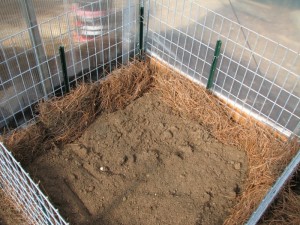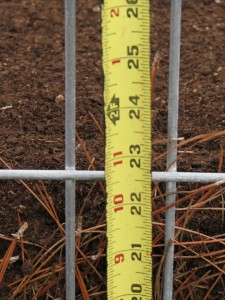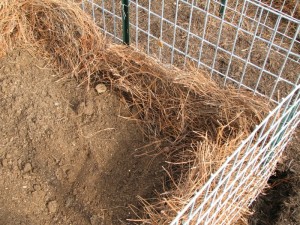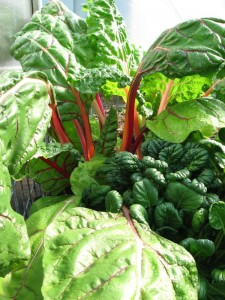Penning the Plants
 In an earlier post, I alluded to “bins” or “pens” That I constructed in the greenhouse. Something of a cross between a raised bed and a giant pot, these miniature gardens are very efficient, and easy to construct. Here’s how:
In an earlier post, I alluded to “bins” or “pens” That I constructed in the greenhouse. Something of a cross between a raised bed and a giant pot, these miniature gardens are very efficient, and easy to construct. Here’s how:
Start by getting some small “T” posts (the kindcommonly used to anchor erosion fencing) and some kind of rigid fencing. Stock panels are ideal for this purpose, and are easy to find in ranch supply stores like Tractor Supply.
They typically come in 10 foot by 20 foot pieces, with 2 and 4-inch wire spacing. A medium-sized bolt cutter is handy to cut the panels.
Determine how big you want your “pens” to be. I decided that a 4-foot square was just right — big enough to hold lots of plants while not-so-big to reach across. That size also worked out well in my 12-foot by 20-foot greenhouse. The pens are about 30 inches tall — enough for a couple feet of dirt with room above for deeper soil if that’s called for later. Once you’ve decided on a size, pound the “T” posts at intervals around the desired outline of the pen. I used a post in each corner and one in the middle of each panel — 8 posts in all. Remember, dirt, water and plants can be heavy, and you want the sides of the pen to be relatively rigid. Now, line the pen with some kind of organic material to contain the soil.
Bales of pine needles are available at one of our local nurseries and they are attractive, while containing the soil well. Many other materials are possible however — use what you have or can obtain easily. I found it easier to line the bottom first with a few inches of pine needles going up the sides and then adding dirt. More pine needles up the side, more dirt, and so on until you reach the desired depth of soil. Now you’re ready to plant!
I started with swiss chard, radishes, beets, bok choy, broccolini, malabar spinach, lettuce and mustard greens. It was the end of January, and still cold at night. We don’t get a lot of cold weather in the Texas Hill country each year, but enough that I was still using the propane heater a little each night.
With propane-aided 50-degree nights and sunshine-aided 80-degree days, the plants grow quickly. There were radishes by mid-March, with the greens becoming usable shortly after that. It’s also easy to regulate the water in a greenhouse — something that encourages rapid growth. The little battery-powered water timersavailable at most home improvement stores are perfect for this application. A little water delivered consistently twice a day is perfect.
And how did they taste? Great! I’ve had lettuce, greens, chard and radishes all spring — long before there was any produce available in the garden. What a great way to keep fresh produce through the winter months!




